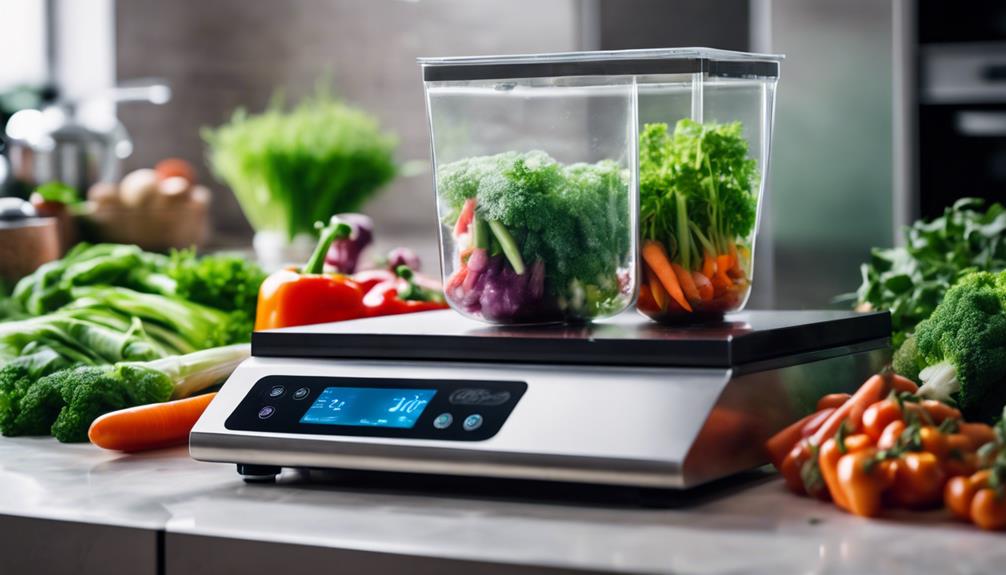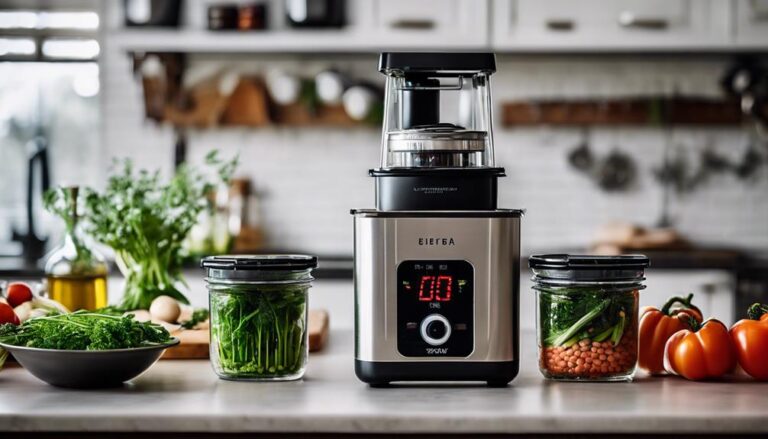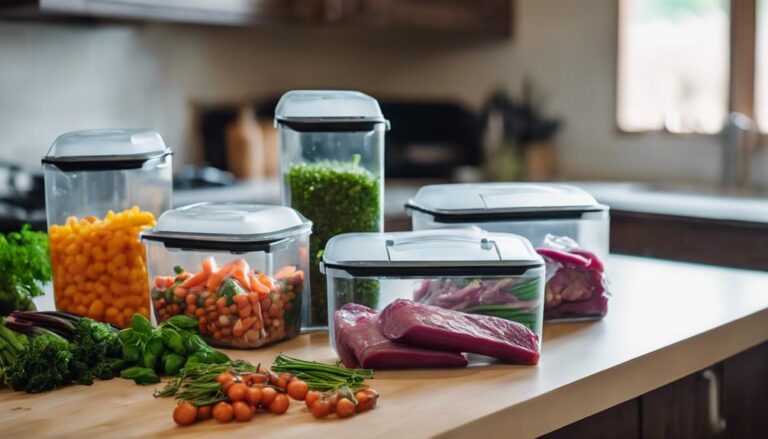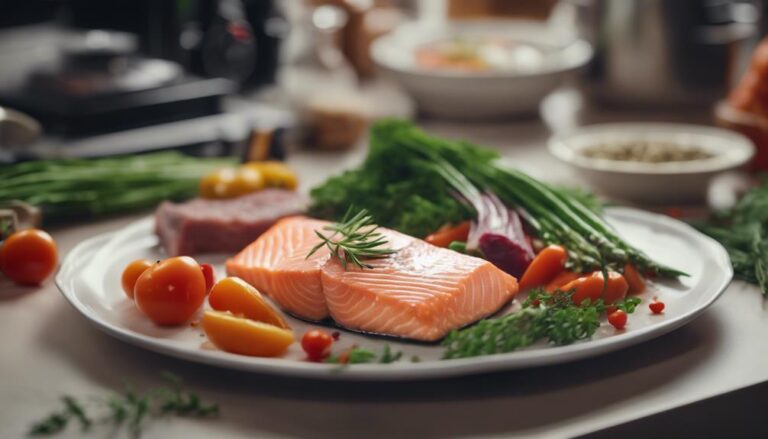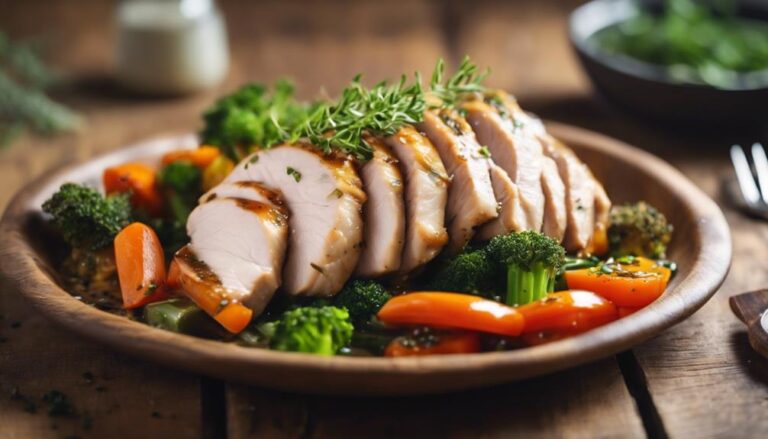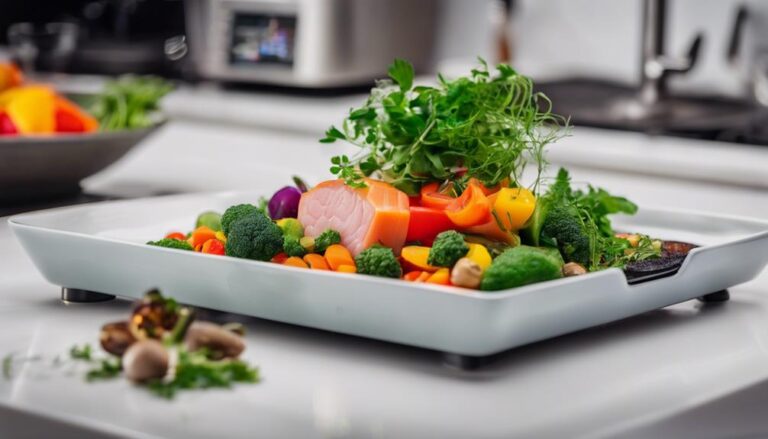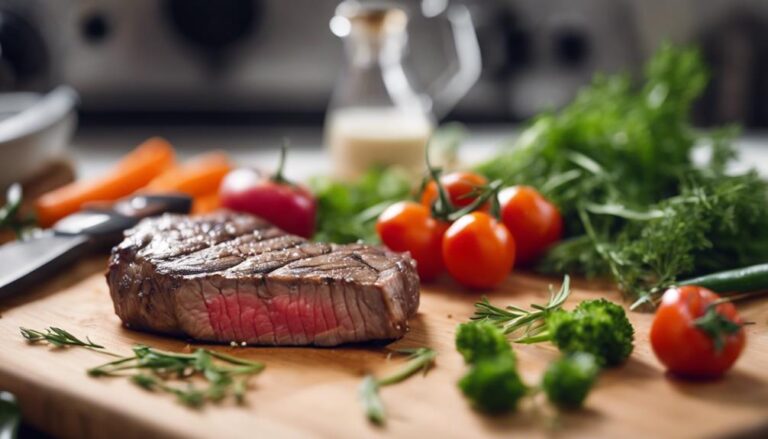The Science Behind Sous Vide and Weight Loss
Sous vide cooking is a method that uses precise temperature control to prepare food in vacuum-sealed bags, which helps retain moisture and nutrients. This technique preserves more than 90% of the nutritional value in vegetables and encourages the use of lean proteins, essential for weight loss. By allowing better portion control and minimizing reliance on unhealthy fats, sous vide helps you create calorie-controlled meals. Plus, it enhances flavors without excessive seasoning, making meals more enjoyable. This method can simplify meal prep and support healthier eating habits, leading to successful weight management and healthier choices over time.
What You Will Learn Here
- Sous vide cooking preserves up to 90% of nutrients in vegetables, supporting healthier meals and weight loss goals.
- This method allows for precise portion control, promoting mindful eating and adherence to calorie management.
- Cooking proteins at controlled temperatures enhances their flavor and moisture retention without adding unhealthy fats.
- Sous vide minimizes oxidation and flavor loss, resulting in richer, more enjoyable meals that encourage healthier eating habits.
Understanding Sous Vide Cooking
Sous vide cooking is a precise technique that seals food in vacuum bags and immerses it in a water bath, allowing you to enjoy enhanced flavors and nutrients. This innovative method employs temperature control, usually between 50°C to 80°C, to achieve even cooking without the risk of overcooking. By maintaining consistent temperatures, you guarantee that moisture retention is maximized, resulting in juicy, flavorful dishes.
One of the standout benefits of sous vide cooking is its ability to transform tougher cuts of meat into tender, enjoyable meals. The slow cooking process breaks down collagen, allowing these cuts to become tender without losing essential flavors.
Nutritional retention is another advantage, as studies show that vegetables prepared sous vide can maintain more vitamins than those boiled, which often lose significant nutrients.
Additionally, sous vide minimizes oxidation, preserving the integrity of your food. With this technique, you can prepare healthy meals that are rich in flavors and nutrients while reducing the need for added fats or preservatives.
Embracing sous vide cooking means you're not just cooking; you're innovating your approach to meal preparation.
Nutritional Benefits of Sous Vide
Cooking with sous vide offers remarkable nutritional benefits, helping you retain vitamins and nutrients that traditional methods often lose. This innovative technique preserves up to 90% of the nutritional value in vegetables, compared to over 60% lost through boiling. When you cook sous vide, you're using lower cooking temperatures, which stabilizes heat-sensitive vitamins, ensuring that the nutritional integrity of your food remains intact.
Moreover, sous vide requires minimal added fats, promoting healthier meal preparation. Oils and butter are used mainly for flavor enhancement rather than as cooking agents, allowing you to enjoy meals with fewer unhealthy fats. Sealing food in vacuum bags considerably reduces oxidation, which helps maintain the quality of polyunsaturated fatty acids, essential for heart health.
Additionally, studies indicate that sous vide cooking retains higher antioxidant activity in foods, contributing to overall health benefits. By keeping these nutrients intact, you're not only enhancing the flavor and texture of your meals but also supporting your weight management goals.
Embracing sous vide means you're choosing a cooking method that prioritizes nutrition and supports a healthier lifestyle.
Weight Loss and Meal Prep
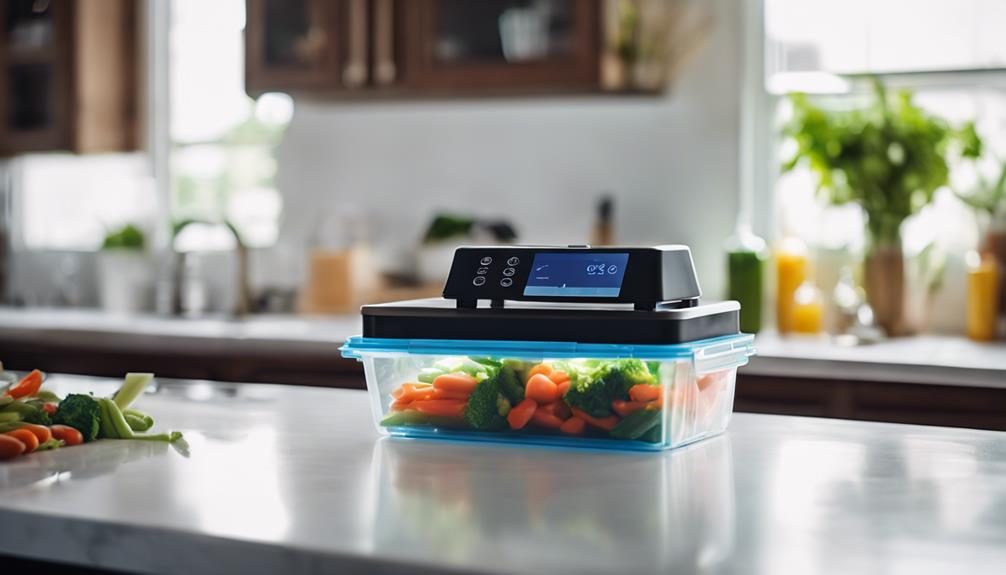
Embracing sous vide not only enhances nutrition but also makes meal prep easier, allowing you to create delicious, calorie-controlled dishes that support your weight loss journey. This innovative cooking technique provides precise control over portion sizes and nutrient retention, which is essential for effective meal prep.
By using sous vide, you can prepare meals that retain higher levels of vitamins and nutrients in vegetables, promoting a healthier diet vital for weight management.
When you cook lean proteins evenly and tenderly with sous vide, you incorporate more healthy protein sources into your meal plans, aiding in muscle preservation during weight loss. Preparing meals in advance with this method leads to better portion control, helping you resist unhealthy convenience foods that may derail your goals.
Additionally, you can utilize sous vide to create a variety of calorie-controlled meals that are both satisfying and nutritious. With this approach, you're not just cooking; you're crafting meals that align with your weight loss objectives while enjoying the benefits of innovative cooking techniques.
Ultimately, sous vide simplifies meal prep, making it easier for you to stay on track and achieve your health goals.
Flavor Retention in Cooking
When you cook with sous vide, you're not just locking in moisture; you're also preserving essential nutrients and enhancing flavors.
This method allows the food to soak up spices and marinades more effectively, resulting in a richer taste profile.
Plus, the controlled environment minimizes any loss of flavor, making your meals both delicious and nutritious.
Nutrient Preservation Benefits
Sous vide not only locks in flavors but also preserves essential nutrients, making your meals both delicious and healthful. This innovative cooking method boasts impressive nutrient preservation benefits. For instance, sous vide can retain up to 90% of the vitamins in vegetables, while traditional boiling might strip away over 60% due to nutrient leaching into the water.
The sealed environment of sous vide reduces oxidation, which helps keep the nutritional quality of polyunsaturated fatty acids intact, enhancing their health benefits. By cooking at lower temperatures, you can safeguard heat-sensitive vitamins like vitamin C and B vitamins, resulting in more nutritionally dense meals.
Moreover, sous vide's precise temperature control prevents moisture loss, ensuring your food stays juicy and flavorful. This not only makes for a more enjoyable dining experience but also encourages healthier cooking practices.
With minimal added fats, you can create flavorful dishes that support your weight loss journey without sacrificing taste. By embracing sous vide, you're opting for a cooking method that combines efficiency with nutrient preservation, paving the way for healthier meals that delight your palate.
Enhanced Flavor Profile
Along with preserving nutrients, sous vide cooking elevates the flavor of your meals by sealing in natural tastes and aromas. This innovative method enhances taste profiles by locking in volatile aroma compounds that traditional cooking often loses.
When you cook sous vide, you're creating a sealed environment that minimizes oxidation, protecting the flavors and nutritional content of your ingredients.
The low-temperature cooking process allows flavors to gradually infuse into your food, resulting in enhanced taste without the need for excessive seasoning. As you enjoy your dish, you'll notice a remarkable juiciness and tenderness, thanks to the method's ability to drastically reduce moisture loss.
This retention of moisture contributes to a more satisfying eating experience, as the flavors remain vibrant and complex. Studies show that sous vide can retain over 90% of volatile aroma compounds, which means your meals not only taste better but also maintain their nutritional quality.
Moisture Retention Techniques
By utilizing moisture retention techniques, you can guarantee your meals remain juicy and packed with flavor, enhancing your overall dining experience. Sous vide cooking stands out for its ability to retain over 90% of moisture in proteins, resulting in tender textures that elevate taste without relying on unhealthy fats or heavy sauces. The sealed environment of sous vide prevents evaporation and oxidation, assuring that the natural flavors and aromas of your food are preserved throughout the cooking process.
When you cook vegetables sous vide, they not only maintain their vibrant colors but also retain essential nutrients. Studies show that these vegetables can keep 30-50% more antioxidants compared to traditional boiling methods. This technique allows delicate proteins, like fish, to remain tender and flavorful, avoiding the dryness often associated with conventional cooking.
Moreover, flavor compounds from marinades and seasonings are better retained in sous vide cooking. The sealed bags prevent the loss of volatile aromatic compounds that typically evaporate during high-heat methods.
Portion Control With Sous Vide
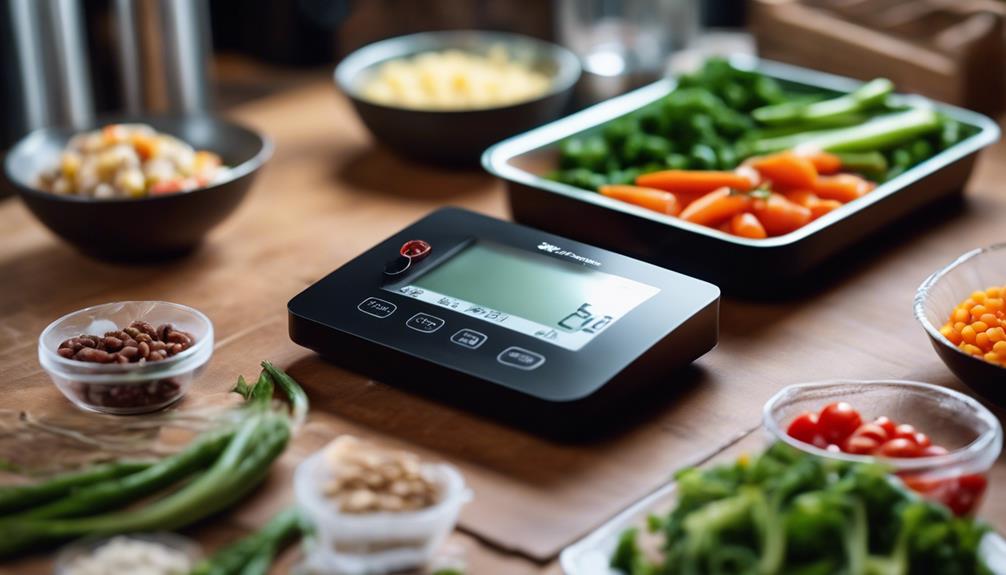
Using sous vide cooking makes it easy to control portions, ensuring each meal is perfectly cooked and flavorful without the risk of overindulging. By utilizing vacuum-sealed bags, you can cook individual servings at a precise temperature, which promotes consistent portion sizes. This method helps you avoid the pitfalls of traditional cooking, where overcooking often leads to dry, unappealing food that encourages larger portions to compensate for the lack of flavor.
Meal-prepping with sous vide not only saves time but also supports weight management and a balanced diet. When you prepare portion-controlled meals in advance, you're more likely to stick to your dietary goals and make healthy choices. The tender results achieved through sous vide cooking mean that you can enjoy satisfying portions without feeling deprived or tempted by less nutritious options.
Incorporating sous vide into your cooking routine can revolutionize your approach to portion control. By focusing on appropriate serving sizes and preventing overcooking, you'll set yourself up for success in maintaining a healthy lifestyle. Embrace sous vide as a powerful tool for achieving your weight loss and nutrition goals.
Cooking Techniques for Lean Proteins
When you cook lean proteins using sous vide, you gain the advantage of ideal temperature control.
This method not only helps retain the nutritional value of your food but also guarantees that proteins are cooked evenly and stay moist.
Optimal Temperature Control
Sous vide cooking allows you to achieve ideal temperature control for lean proteins, guaranteeing they remain juicy and flavorful while minimizing moisture loss.
By cooking at lower temperatures, typically between 54.4°C and 65°C (130°F to 149°F), you enhance moisture retention without excess fat. For example, cooking chicken breast at 65°C (149°F) for 1.5 to 2 hours not only results in a tender texture but also assures food safety by effectively pasteurizing harmful pathogens.
Fish, like salmon, benefits from sous vide as well; cooking it at 50°C to 60°C (122°F to 140°F) for 30 minutes to an hour preserves delicate flavors and nutrients that high-heat cooking methods often destroy. This precise control over temperature helps minimize moisture loss, allowing lean proteins to maintain their natural flavors.
As a result, you can avoid adding unhealthy fats or sauces that might sabotage your weight loss efforts.
Studies show that sous vide can notably improve the palatability of lean meats, such as turkey and pork loin, making healthy meal choices more appealing.
Retaining Nutritional Value
Retaining the nutritional value of lean proteins is essential for maintaining a healthy diet, and sous vide cooking excels in preserving vitamins and nutrients that traditional methods often lose. This innovative technique allows you to enjoy perfectly cooked chicken, fish, or other proteins while ensuring they retain their health benefits.
Here are a few reasons why sous vide is a game-changer for your meals:
- Preservation of Nutrients: Sous vide retains over 90% of vitamins and nutrients, while traditional cooking can result in over 60% loss.
- Precise Temperatures: Cooking at controlled low temperatures keeps proteins moist and tender, reducing the need for added fats and calories.
Safety and Food Quality
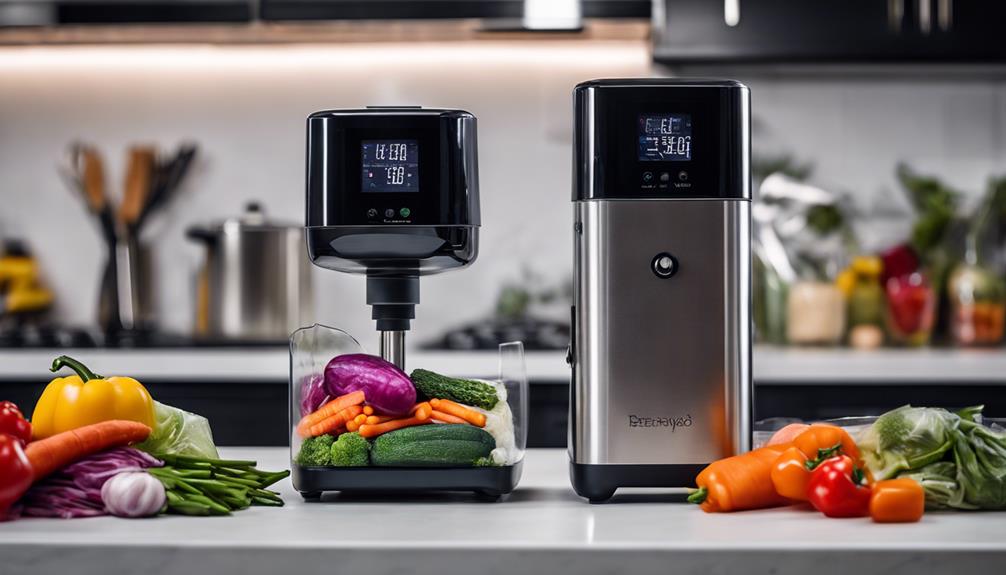
Precise temperature control in sous vide cooking guarantees food safety by effectively reducing the risk of pathogen survival, especially in sensitive items like seafood and meats.
By maintaining specific temperatures for recommended durations, you can greatly extend the shelf life of sous vide products, with some foods lasting an impressive 42 days. This innovation not only keeps your food safe but also preserves its nutritional quality.
The vacuum-sealed environment of sous vide cooking minimizes oxygen exposure, which greatly reduces lipid oxidation. This means that the fatty acids and vitamins in your meals stay intact, ensuring you get the most out of every bite.
Following HACCP (Hazard Analysis Critical Control Point) protocols further enhances food safety by addressing risks associated with psychrotrophic pathogens like Listeria monocytogenes.
Moreover, sous vide cooking retains higher antioxidant activity in vegetables compared to traditional boiling methods, enhancing both food quality and nutritional value.
With these advanced cooking practices, you can enjoy delicious meals while prioritizing safety and nutrition, making sous vide a smart choice in today's culinary landscape.
Embrace this technique, and elevate your cooking experience while ensuring your food is both safe and nutritious.
Enhancing Vegetables and Seafood
Cooking vegetables and seafood using sous vide preserves their vibrant colors, rich flavors, and essential nutrients, making your meals both delicious and healthy. This innovative method minimizes nutrient loss, retaining over 90% of vitamins compared to traditional boiling, which can strip away over 60%. By utilizing low cooking temperatures between 50°C to 80°C, sous vide enhances the appearance, flavor, and texture of vegetables, making them more appealing.
Here are some benefits of sous vide for enhancing your meals:
- Retains Nutritional Content: Keeps essential vitamins intact, boosting health benefits.
- Maintains Moisture: Prevents overcooking in seafood, preserving delicate textures and flavors.
Practical Tips for Home Cooks
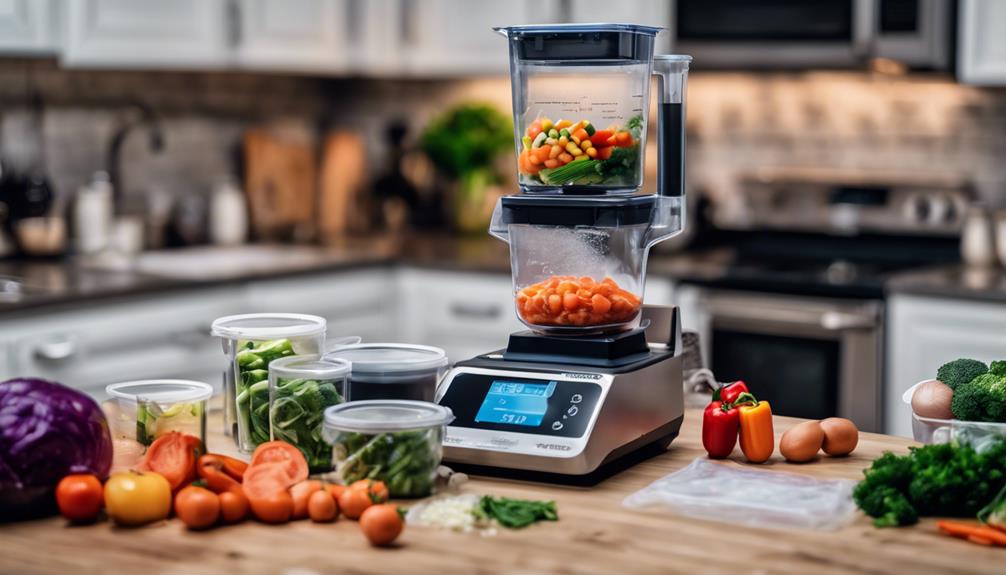
To get the most out of sous vide at home, focus on using lean proteins and vibrant vegetables that retain their flavor and nutrients while helping you stick to your weight loss goals.
Start by cooking proteins like chicken breast or fish at lower temperatures, which preserves moisture and flavor while cutting down on added fats. This method makes it easier to maintain a healthy diet.
Don't overlook your vegetables! Cooking them sous vide can help lock in their vibrant colors and essential nutrients, unlike traditional boiling methods that often strip away crucial health benefits.
When preparing your meals, experiment with different herbs and spices in the sous vide bags. This adds delicious flavors without introducing extra calories from sauces or dressings.
Utilize precise temperature control to guarantee your proteins reach the perfect doneness, avoiding the risk of overcooking.
Finally, consider meal prep; cooking in bulk allows you to manage portion sizes while reducing the temptation of higher-calorie convenience foods during busy weeks.
With these practical tips, you can make sous vide a cornerstone of your weight loss journey, enhancing both your meals and your health.
Frequently Asked Questions
What Is the Science Behind Sous Vide Cooking?
Sous vide cooking relies on precise temperature control to guarantee food is cooked evenly and safely.
By using sous vide equipment, you can achieve cooking precision that enhances flavor and improves texture.
This technique preserves nutrients through lower cooking temperatures, preventing vitamin loss.
Extended cooking times allow for better tenderness, especially in meats, while also enhancing meal prep efficiency.
What Happens to Fat in Sous Vide?
Did you know that cooking sous vide can reduce fat breakdown by up to 30%?
With precise temperature control, you enhance flavor and improve texture while preserving nutrients.
The low temperatures retain moisture, making your meals juicy and tender.
This method aids portion management and calorie counting, allowing for innovative meal prep.
You can enjoy delicious dishes without excess fats, achieving a healthier balance in your cooking routine.
Does Sous Vide Release Toxins?
When you consider sous vide safety, it's crucial to address toxin release from plastic materials.
Most food-grade bags used for sous vide are designed to minimize BPA concerns and are safe at lower cooking temperatures.
This method enhances meal prep by retaining food quality and nutrient retention, while also improving flavor.
What Are the Disadvantages of Sous Vide Cooking?
Imagine a chef in a high-tech kitchen, maneuvering sous vide limitations.
You'll find that while the method retains nutrients, it can lead to texture changes, leaving some veggies overly soft.
The cooking time can be lengthy, which isn't ideal for quick meal prep.
Equipment costs can add up, and if you're not careful, food safety risks arise.
Plus, flavor intensity might suffer without proper seasoning.
Balancing energy consumption and culinary skills is essential.
Conclusion
Incorporating sous vide into your cooking routine can be like planting seeds for a healthier lifestyle.
By utilizing precise temperature control, you not only enhance the flavors of your meals but also support your weight loss journey.
With its ability to preserve nutrients and promote portion control, sous vide empowers you to create delicious, nutritious dishes that align with your goals.
Embrace these techniques, and watch your culinary skills flourish while you enjoy the benefits of a balanced diet.
